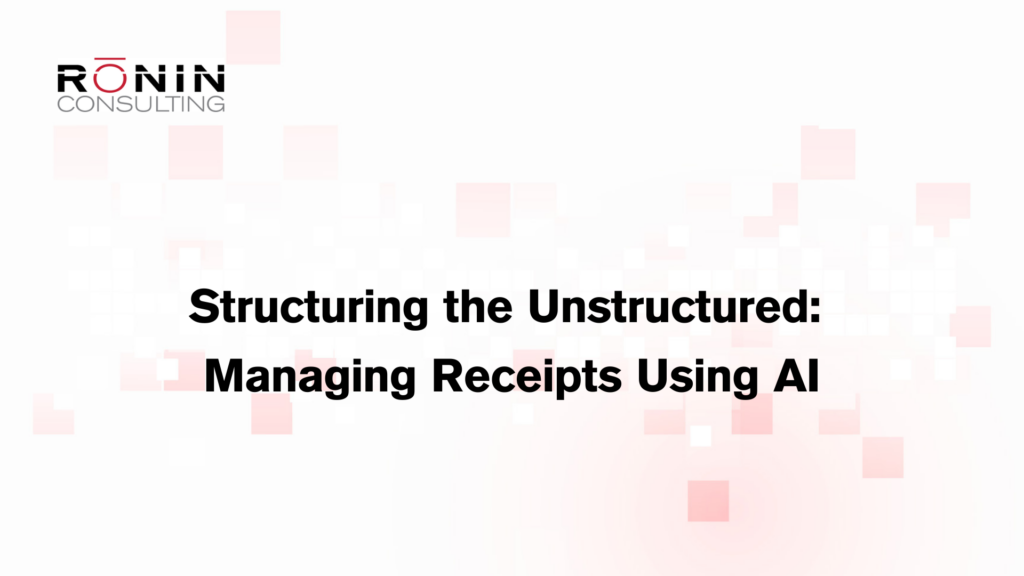
This article is part of a series exploring how businesses can leverage AI to manage unstructured data effectively. Our first article introduced the concept of unstructured data—what it is, why it matters, and how organizations can benefit from using AI to make sense of it.
This second installment looks deeper using a specific use case: managing receipts using AI. We examine how unstructured receipts data presents challenges, and we demonstrate how AI transforms receipt processing from a manual, time-consuming task into an automated and efficient solution.
Receipts data flow: a practical AI use case
Organizations across industries rely on receipts for expense tracking, reimbursements, compliance, and fraud detection. However, extracting useful information from these documents has always been a challenge. Receipts come in a tremendous variety of formats, layouts, image qualities, and languages, making consistency and accuracy challenging to maintain.
Previous methods for importing receipt data involved manual processes or time-intensive and brittle OCR solutions. These approaches are time consuming, difficult to scale, and prone to error.
Fortunately, businesses have moved beyond paper-stacked receipts. Today businesses use AI to interpret unstructured data, extracting key details quickly and accurately.
Our example below uses receipts from international travel, where multilingual content, varied layouts, and inconsistent structures create processing challenges. Despite these complexities, we demonstrate that AI models efficiently extract key data elements such as merchant names, dates, itemized purchases, total amounts, and payment methods, regardless of formatting variations.
Putting it all together
We leveraged GPT with a simple yet effective UI to demonstrate how AI elegantly transforms unstructured data into structured, relational data. This proof of concept is an example a business can implement to automate complex data extraction, eliminate manual input, and improve accuracy and efficiency. Let’s explore how this system works in practice.
Extracting the raw data
The process begins with a document, either a receipt image or a PDF, fed into the AI model. The model identifies and extracts relevant fields, accurately recognizing patterns, extracting numeric values, and preserving context between data fields.
Writing the prompt
To structure the extracted data, we provide the model with a prompt to generate unschematized JSON. This prompt ensures that:
- The extracted information is organized into a structured JSON format while maintaining any inherent document structure.
- The model understands the type of data expected but remains flexible to handle variations.
- No fabricated data is included.
- Any missing fields are populated with null values.
No manual data mapping is required—the model seamlessly handles the transformation based on a reference schema.
Transforming the data
To refine the extracted data, we provide the model with additional instructions:
- A “raw” JSON output is paired with a “reference” JSON that defines the desired schema.
- The prompt includes detailed formatting guidelines to ensure consistency.
- If the data requires language translation, the model performs it during this step.
The final product
After AI extracts and transforms the data into JSON, the application inserts it into target tables. We built a lightweight user interface (UI) to enhance usability, allowing users to review and interact with processed records. While not a market-ready product, this UI effectively demonstrates how AI converts unstructured data into structured formats, enabling users to verify accuracy and adjust as needed. This demo is just a quick glimpse into what you could build using this process:
AI’s role in enhancing receipt processing
Traditional rule-based systems struggle with the variability of receipts, often requiring extensive manual intervention and predefined templates. AI revolutionizes receipt processing by offering a more flexible and intelligent approach. Here are some benefits of tapping into your unstructured data while using AI:
- Context-Aware Processing – AI understands the structure and meaning of receipt data, extracting key details while preserving relationships between fields.
- Adaptability – Unlike static templates, AI dynamically adjusts to new receipt formats and variations without requiring manual reprogramming.
- Scalability – Businesses can process large receipts in real time, reducing human workload and accelerating financial workflows.
- Improved Accuracy – AI reduces errors common in manual data entry and rule-based extraction, ensuring cleaner, more reliable financial data.
- Actionable Insights – By structuring receipt data efficiently, businesses gain deeper insights into spending patterns, vendor relationships, and operational costs.
Organizations that process a large volume of receipts will see significant benefits from using AI in this way. Instead of just extracting data, AI enables a more advanced, flexible, and efficient method to convert unstructured receipt data into structured, relational data that is both meaningful and easier to use.





